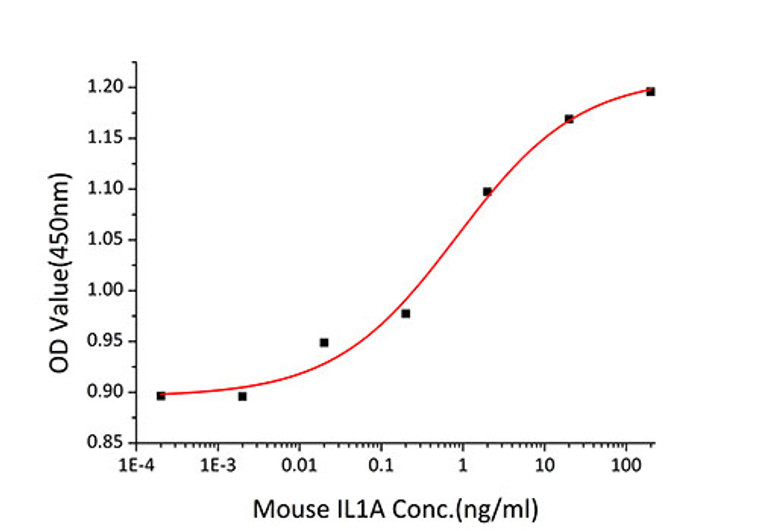| Host: |
HEK293 cells |
| Reactivity: |
Mouse |
| Note: |
STRICTLY FOR FURTHER SCIENTIFIC RESEARCH USE ONLY (RUO). MUST NOT TO BE USED IN DIAGNOSTIC OR THERAPEUTIC APPLICATIONS. |
| Short Description: |
Recombinant-Mouse IL-1 alpha-C-His protein was developed from hek293 cells and has a target region of C-His. For use in research applications. |
| Formulation: |
Lyophilized from a 0.22 Mu m filtered solution of PBS, pH 7.4. |
| Immunoreactivity: |
Measured in a cell proliferation assay using D10.G4.1 mouse helper T cells. The ED50 for this effect is 0.420-1.68 ng/mL. |
| Gene Symbol: |
Il1a |
| Gene ID: |
16175 |
| Uniprot ID: |
IL1A_MOUSE |
| Immunogen Region: |
Ser115-Ser270 |
| Immunogen: |
Recombinant Mouse IL-1 alpha Protein is produced by HEK293 cells expression system. The target protein is expressed with sequence (Ser115-Ser270) of Mouse IL1a (Accession #NP_034684.2) fused with an 6×His tag at the C-terminus. |
| Post Translational Modifications | Acetylated within its nuclear localization sequence, which impacts subcellular localization. Proteolytic processed by CAPN1 in a calcium-dependent manner. Cleavage from 31 kDa precursor to 18 kDa biologically active molecules. Phosphorylated. Phosphorylation greatly enhances susceptibility to digestion and promotes the conversion of pre-IL1A alpha to the biologically active IL1A. |
| Function | Cytokine constitutively present intracellularly in nearly all resting non-hematopoietic cells that plays an important role in inflammation and bridges the innate and adaptive immune systems. After binding to its receptor IL1R1 together with its accessory protein IL1RAP, forms the high affinity interleukin-1 receptor complex. Signaling involves the recruitment of adapter molecules such as MYD88, IRAK1 or IRAK4. In turn, mediates the activation of NF-kappa-B and the three MAPK pathways p38, p42/p44 and JNK pathways. Within the cell, acts as an alarmin and cell death results in its liberation in the extracellular space after disruption of the cell membrane to induce inflammation and alert the host to injury or damage. In addition to its role as a danger signal, which occurs when the cytokine is passively released by cell necrosis, directly senses DNA damage and acts as signal for genotoxic stress without loss of cell integrity. |
| Protein Name | Interleukin-1 AlphaIl-1 Alpha |
| Database Links | Reactome: R-MMU-448706Reactome: -MMU-5620971Reactome: -MMU-9020702 |
| Cellular Localisation | NucleusCytoplasmSecretedThe Lack Of A Specific Hydrophobic Segment In The Precursor Sequence Suggests That Il-1 Is Released By Damaged Cells Or Is Secreted By A Mechanism Differing From That Used For Other Secretory ProteinsThe Secretion Is Dependent On Protein Unfolding And Facilitated By The Cargo Receptor Tmed10It Results In Protein Translocation From The Cytoplasm Into The Ergic (Endoplasmic Reticulum-Golgi Intermediate Compartment) Followed By Vesicle Entry And SecretionRecruited To Dna Damage Sites And Secreted After Genotoxic Stress |
| Alternative Protein Names | Interleukin-1 Alpha proteinIl-1 Alpha proteinIl1a protein |
Information sourced from Uniprot.org
12 months for antibodies. 6 months for ELISA Kits. Please see website T&Cs for further guidance









